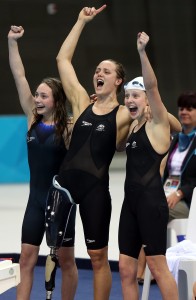Swimming Australia in conjunction with Play by the Rules have joined forces to help make swimming more accessible to all Australians with the new Inclusive Swimming Framework and 7 Pillars website, that launched on Monday 23 November.
 The Inclusive Swimming Framework (ISF) will guide Swimming Australia, its stakeholders and aquatic partners toward achieving full inclusion of people from the diverse array of circumstances and backgrounds in swimming and aquatic activities by knocking down the barriers that may prevent them from accessing the sport.
The Inclusive Swimming Framework (ISF) will guide Swimming Australia, its stakeholders and aquatic partners toward achieving full inclusion of people from the diverse array of circumstances and backgrounds in swimming and aquatic activities by knocking down the barriers that may prevent them from accessing the sport.
Swimming Australia CEO Mark Anderson said we want to give all Australians the opportunity to be involved in swimming and we want to inspire them to be the swimmer they want to be.
“Swimming is an important part of our national identity and as a Nation surrounded by water, it is in our DNA. As custodians of swimming, we accept our responsibility to ensure that all Australians have the chance to become involved, develop and excel in both in and out of the water. We acknowledge that not every Australian has easy access to getting involved and that for many there may be barriers and these are our responsibility to overcome.
The introduction of the Inclusive Swimming Framework is intended to provide the swimming and aquatics industry with a consistent approach to enabling access and participation. It is an approach that highlights the common factors that contribute to achieving diversity, rather than focusing on difference.”
With summer just around the corner, Social Inclusion week from November 21 to 29 and then International Day for People with Disability on December 3, the launch of the 7 Pillars of Inclusion website and Inclusive Swimming Framework comes at a pivotal time in the swimming season.
Swimming Australia Paralympic Pathways Senior Coordinator Michael Woods said it will help people understand where to start on the journey toward a more inclusive and diverse community.
“The 7 Pillars of Inclusion is about giving you a ‘helicopter’ view of inclusion. It looks at the common elements of inclusive practice across different population groups, such as people with disability, people from culturally and linguistically diverse backgrounds, Indigenous Australians and so on. It’s a framework to help you identify your strengths and weaknesses and it will give you a great starting point in designing strategies for inclusive practice.”
Mark Anderson added that the ISF applies at all levels of the sport, from swim schools and clubs through to our elite teams and the administration of Swimming Australia and our stakeholders.
“While Swimming Australia seeks to take a leadership role in this endeavour, I acknowledge that this is not something that Swimming Australia can do alone. The key to success is ensuring all stakeholders in the swimming and aquatics community feel empowered and involved.
Every Australian should have the opportunity to be involved in swimming in the role and level of their choosing. Through the Inclusive Swimming Framework, it is Swimming Australia’s goal to achieve this by ensuring our sport is reflective of the Australian community,” Anderson said.
The website, which launched on Monday November 23, will aim to provide the swimming and aquatics industry with a consistent approach to enabling access and participation. An approach that highlights the common factors that contributes to achieving diversity, rather than focusing on difference.
To access the 7 Pillars of Inclusion website, follow this link: http://7pillarsofinclusion.com/swimming/
For more information on Social Inclusion week, follow this link: http://www.socialinclusionweek.com.au/
Play by the Rules is a joint initiative between the Australian Sports Commission, the Australian Human Rights Commission, all state and territory departments of sport and recreation and equal opportunity commissions, the Australian and New Zealand Sports Law Association and the Office of the Children’s Guardian.
By Swimming Australia
Posted: 24/11/2015


